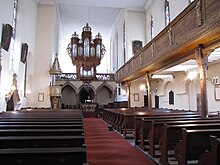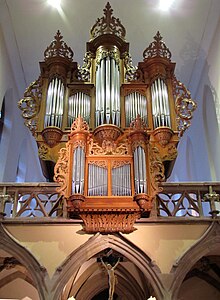Wilhelmskirche (Strasbourg)
The Wilhelmskirche or Wilhelmerkirche (Église Saint-Guillaume) is an Evangelical Lutheran church building within the Protestant Church of the Augsburg Confession of Alsace and Lorraine in the city of Strasbourg in Alsace . It is remarkable for its location on the Ill , its “crooked” exterior and its rich Gothic and Baroque interior. Due to its good acoustics, it has also been used as a venue for performances of classical sacred music, especially the Passions of Johann Sebastian Bach, since the end of the 19th century .
architecture
The elongated Gothic building, completed in 1307, was originally the church of a mendicant monastery of the Wilhelmites or Wilhelmer after Wilhelm von Malavalle , Duke of Aquitaine (1086–1157), which can still be recognized by the single-aisle structure and the simple exterior. In 1667 the asymmetrical bell tower was built over the main entrance. The leaning structure of the building is due to the muddy ground on which it was built and can also be seen in other houses in the Krutenau district .
Furnishing
- Remains of a Gothic portal in the vestibule
- Numerous high and late Gothic leaded glass windows , including several by Peter Hemmel von Andlau
- Elaborate double grave of the brothers Philipp and Ulrich von Werd (14th century)
- Fragments of a rood screen (1485)
- Painted relief panel "Saint Wilhelm" made of oak (16th century)
- Pulpit from 1656
- Main altar from 1767
Silbermann organ
The organ of the Wilhelmerkirche was built by Andreas Silbermann in 1728 and is the oldest Silbermann organ in Strasbourg that has remained in place . However, only the baroque housing is the original. The organ itself has undergone numerous changes in the meantime. Today it has 30 stops on two manuals and a pedal. The actions are mechanical.
|
|
|
||||||||||||||||||||||||||||||||||||||||||||||||||||||||||||||||||||||||||||||||||||||||||||||||||||||||||||||||||||||||||||||||||||||||
- Coupling : II / I, I / P, II / P
Bells
The ringing consists of two bells, the notes f sharp 'and a'. A third bell that can no longer be rung is at the entrance to the church. It was cast by Ernst Friedrich Puffendorff in 1755. Three smaller bells strike the hour.
history
Knight Heinrich von Mülnheim , who came from a Strasbourg patrician family, was Ludwig IX. followed to Tunis in the seventh crusade in 1270 . When the crusaders were struggling with unspeakable misery there, he vowed, if he saw his hometown Strasbourg again, to build a church in gratitude, which he founded in 1300.
From 1693 to 1697 the composer and later pastor Johann Georg Keifflin (1672–1728) from Diemeringen worked as an organist at the church during his student days. He wrote the motet Elevation here in 1696 . Aspiratio ad Christum for solo voice, 2 violins, bassoon and basso continuo, which has been preserved in a manuscript by Sébastien de Brossard .
From 1826 to 1837 the poet Johann Jakob Jägle was pastor at the Wilhelmerkirche.
The Wilhelmerkirche choir, founded in 1885 by the organist Ernst Münch (1859–1928), is known nationwide and has been directed by famous conductors such as Wilhelm Furtwängler , John Eliot Gardiner and Charles Münch , the son of Ernst Münch.
literature
- Some news about the parish church of Sanct Wilhelm in Strasbourg, Strasbourg 1818
- Gustav Lasch, Eugen Herrmann, Robert Will (Hrsg.): History of the Wilhelmer Church in Strasbourg in Alsace. Three contributions, Strasbourg 1914
Web links
- Parish website
- The baroque, restored organ
- Exterior and interior views
- Black and white photo of the von Werd brothers' double grave ( memento from October 22, 2007 in the Internet Archive )
Individual evidence
- ↑ http://www.itinerairesprotestants.fr/de/sehenswurdheiten/strasbourg-8
- ↑ More information on the Silbermann organ ( memento of the original from March 3, 2016 in the Internet Archive ) Info: The archive link was inserted automatically and has not yet been checked. Please check the original and archive link according to the instructions and then remove this notice.
- ^ The old prayer house of All Saints in Strasbourg - German digital library. Retrieved November 8, 2018 .
- ^ Johann Georg Keifflin, Th [eologiae] Aud [itor], 1696, canto Solo cum VVF et organo Dulce Pelicani pectus ; see. Jean-Luc Gester: La musique religieuse en Alsace au XVIIe siècle. Reception de la musique italienne en pays rhénan , Presses Universitaires de Strasbourg, Strasbourg 2001, pp. 196 and 251.
- ↑ Sébastien de Brossard: [anthology] Recueil de motets de différents autheurs [SdB recueil 27] , manuscript 2nd half of the 17th century ( Bibliothèque nationale de France ; Vm 1 1266).
Coordinates: 48 ° 34 ′ 55.8 " N , 7 ° 45 ′ 27" E







